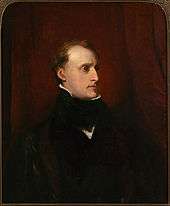Francis Mackenzie, 1st Baron Seaforth

Francis Humberston Mackenzie, 1st Baron Seaforth FRS (9 June 1754 – 11 January 1815) was a British politician, (by right of his ancestry) Chief of the Highland Clan Mackenzie and raised the renowned 78th (Highlanders) Regiment of Foot.
When he was about twelve he suffered from scarlet fever which resulted in his losing his hearing and almost all speech, from this he was known as MacCoinnich Bodhar (Deaf Mackenzie) in Gaelic. He nearly recovered the use of his tongue but during the last two years of his life, mourning the deaths of his four sons, he never made the attempt to articulate.
Origins
Mackenzie was the second son of Major William Mackenzie (died 12 March 1770), by Mary, daughter and heiress of Matthew Humberston of Humberston, in Lincolnshire. His father was the son of the Hon. Alexander Mackenzie and grandson of Kenneth Mackenzie, 4th Earl of Seaforth.[1]
On the death of his elder brother Colonel Thomas Frederick Mackenzie Humberston in 1783, Mackenzie became the last male heir of the attainted Earls of Seaforth.[1]
Military career
In 1784 and again in 1790 he was elected Member of Parliament for the County of Ross. In 1787 he offered to raise a regiment on his own estates to be commanded by himself. The government declined his patriotic offer but accepted his services in procuring recruits for the 74th and 75th. On 19 May 1790 he renewed his offer but the government again declined his services. When war broke out in 1793 he offered for a third time and a letter of service was granted in his favour dated 7 March 1793 empowering him as Lieutenant-Colonel-Commandant to raise a Highland Battalion to be called 78th (Highlanders) Regiment of Foot, known as "Seaforth's Highlanders". The original Mackenzie regiment had had its number previously reduced to 72nd Regiment of Foot. On 10 February 1794 the government agreed to his proposal to raise a second battalion, the Ross-shire Buffs. The two battalions were amalgamated in 1796. Another battalion was raised in 1804 (letter of service dated 17 April) and these were again amalgamated July 1817.
In 1798 he was appointed Colonel of the Ross-shire Regiment of Militia. In 1808 he was made a Lieutenant-General.
Non-military appointments
In 1794 he was elected a Fellow of the Royal Society. He was appointed Lord Lieutenant of Ross and was raised to the peerage of Great Britain as Lord Seaforth and Baron Mackenzie of Kintail on 26 October 1797.[2]
He was Governor of Barbados from 1800–06, during which period he reformed slavery on the island, prohibiting the killing of slaves and easing discrimination against free blacks. Subsequently, he held high office in Demerara and Berbice. In 1801, Lord Seaforth was appointed Grand Master of the Freemasons in Barbados. Mackenzie was known as Seaforth when he held office in the West Indies. Research shows that he probably sought to avoid the curse of Brahan Seer by choosing to use the surname Seaforth. As a result, his descendants from Guyana are known by the name of Seaforth. Records in Demerara identify Francis Mackenzie as Francis Seaforth.

Art supporter
In 1796, he gave £1,000 to Sir Thomas Lawrence to relieve him from his financial difficulties. Lawrence later painted a full-length portrait of Seaforth's daughter, Mary. Lord Seaforth commissioned Benjamin West's painting "King Alexander III of Scotland being rescued from the fury of a stag by the intrepidity of Colin Fitzgerald ."
Quote
‘The last Baron of Kintail, Francis, Lord Seaforth was a nobleman of extraordinary talents, who must have made for himself a lasting reputation had not his political exertions been checked by painful natural infirmities.’ Walter Scott

Family
Mackenzie married, 1782, Mary Proby, daughter of The Very Rev Baptist Proby, 7th Dean of Lichfield and Mary Russell. Mary was sister of John Proby, 1st Baron Carysfort. Francis's four legitimate sons all predeceased him as predicted by the Brahan Seer. However, he had an illegitimate child with a local woman in Demerara (now known as Guyana). Mackenzie has several surviving descendants from that union. His legitimate children were:
- William Frederick Mackenzie (died young)
- George Leveson Boucherat Mackenzie (died young)
- Hon. William Frederick Mackenzie (died 1814), MP for Ross-shire
- Hon. Francis John Mackenzie, midshipman, RN (died unmarried 1813)
- Hon. Mary Elizabeth Frederica Mackenzie, heiress to her father, (married first Admiral Sir Samuel Hood, married second Rt Hon James Alexander Stewart of Glasserton).
- Frances Catherine Mackenzie, dsp
- Caroline Mackenzie (accidentally killed unmarried)
- Charlotte Elizabeth Mackenzie (died unmarried)
- Augusta Anne Mackenzie (died unmarried in 1856) buried in Dean Cemetery
- Helen Ann Mackenzie (married Joshua Henry Mackenzie)
References
- Mackenzie, Alexander (1894). History of the Mackenzies. Inverness: A & W Mackenzie.
- Sidney Lee (ed), Dictionary of National Biography (1891, London, Smith, Elder & Co
- 1 2 Sir James Balfour Paul, The Scots Peerage, volume VII (Edinburgh, David Douglas, 1910), at pages 513–514
- ↑ The London Gazette: no. 14052. p. 968. 7 October 1797.
External links
- "Mackenzie family tree".
- Seaforth's Lewis by Finlay MacLeod
| Military offices | ||
|---|---|---|
| Preceded by New regiment |
Colonel of the 78th (Highlanders) Regiment of Foot 1793–1796 |
Succeeded by Alexander Mackenzie Fraser |
| Parliament of Great Britain | ||
| Preceded by John Mackenzie |
Member of Parliament for Ross-shire 1784–1790 |
Succeeded by William Adam |
| Preceded by William Adam |
Member of Parliament for Ross-shire 1794–1796 |
Succeeded by Sir Charles Lockhart-Ross |
| Government offices | ||
| Preceded by William Bishop, acting |
Governor of Barbados and [Governor of Demerara] 1802–1806 |
Succeeded by John Spooner, acting |
| Honorary titles | ||
| New title | Lord Lieutenant of Ross-shire 1794–1815 |
Succeeded by Sir Hector Mackenzie |
| Peerage of Great Britain | ||
| New creation | Baron Seaforth 1797–1815 | |
| Preceded by Thomas Frederick Mackenzie Humberston |
Chief of Clan Mackenzie 1783–1815 |
Succeeded by Disputed |